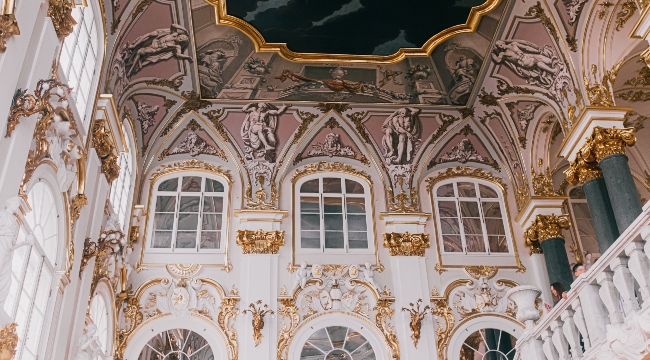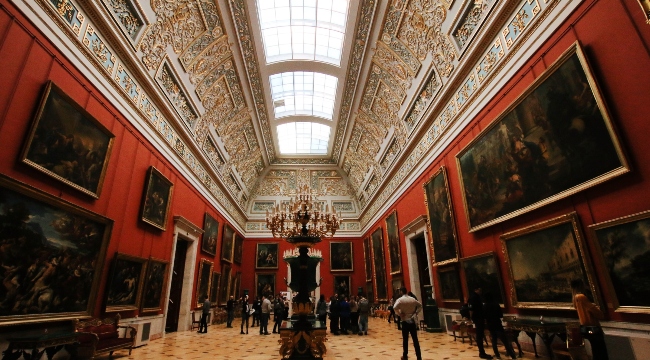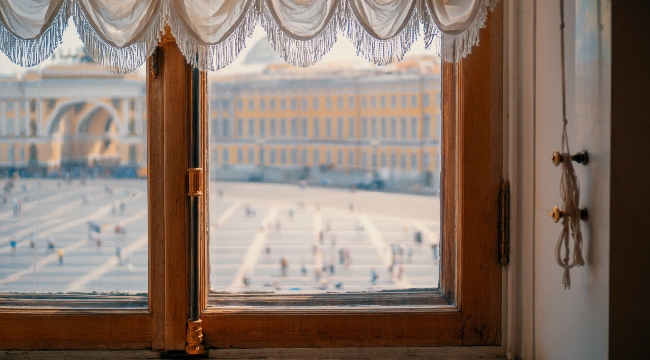There's much more to the Hermitage Museum that its outstanding collection of artwork. For starters, it is one of the greatest and most recognizable landmarks of St. Petersburg, housed in the gorgeous Winter Palace which once belonged to Russian Tsars. But what else is so unique about it? Let's take a closer look.
1. Hermitage is "Exclusive"
Have you ever thought about the word "Hermitage"? Where did it come from? What does it mean? Is it Russian at all?
Even if none of these questions popped in your head before, they most likely have there by now. Don't worry, we are not going to keep you in the dark.
The word "Hermitage" derives from the French "hermit" or Latin "eremita", meaning "people who live alone". It probably doesn't make sense from the first look but it actually does. At the time of its creation, the Hermitage was exclusive in more than one way. First, the project itself was unique, and until now it is an excellent example of Baroque architecture in Russia. Second, the Hermitage was an official residence of Russian Tsars, and for almost 100 years it was not open to the public. Very few people would be allowed to step into the building. This exclusiveness predetermined the museum's name and fate for years to come.

Elitarism of the Hermitage
Surprisingly, but even Alexander Pushkin (the greatest Russian poet) could not visit the Hermitage for a long time. His friend, the poet Vasily Zhukovsky, who was the mentor of the future Emperor Alexander II, helped Alexander Pushkin to receive a pass.
2. Residence of Tsars
As mentioned earlier, the walls which hold outstanding art heritage were once home to the Russian royal family, actually, for almost 200 years. The Winter Palace is part of a gorgeous palatial complex set on the Neva River Embankment and is one of the greatest symbols of Imperial Russia.
Just as many other buildings in St. Petersburg, this one was too designed by outstanding architects, including Bartolomeo Rastrelli. The Winter Palace has also witnessed the Russian Revolution as it was one of the major strategic points of the Soviet governmental takeover, and was even stormed by the Red Army.
3. Hermitage Employs Cats
No, there is no mistake in the statement above. The museum has been employing cats since the times when it wasn't a museum. Specifically, cats were first brought to the Winter Palace by the order of Elizabeth I, the daughter of Peter the Great. She wanted to get rid of mice and rats inhabiting her home. Initially, all the cats were brought from Kazan where apparently lived the biggest representatives of the species. Time passed, but the method proved to be effective, and the cats' role became even more critical when the palace was filled with artwork. According to various sources, 50 to 70 cats are working and living full time on the territory of the museum today.
Qualified Specialists
Each cat has its own passport, veterinary card, and is officially registered as a qualified specialist in cleaning Museum basements from rats.
4. The Hermitage is Huge
You probably know that the Hermitage is not only one of the most famous museums in the world, but it is also one of the largest. But here is some factual information to make your eyes pop.
The State Hermitage museum consists of 5 interconnected buildings (not impressed?) and occupies the territory of almost 719480 sq ft. It is home to over 3 million art pieces, which means that you would stay there for nearly six years should you spend 1 minute by each piece of artwork. And this doesn't even include eating and sleeping time, not to mention that you'd cover the distance of about 24 km (15 mi), walking from one exhibit to the other. Moreover, there are 117 staircases in the Hermitage and more than 18,800 doors! Shocking, huh?
Crowded Roof
There are 176 sculptures on the roof of the Winter Palace, the main building of the Hermitage. The architect placed them there to hide the chimneys from the townspeople.
5. The Fire of 1837
Almost 180 years ago, on December 17th, 1837 a terrible fire broke out in the Hermitage. It was one of the biggest fires in the history of St. Petersburg.
On the day of the disastrous fire there were about 3 thousand people in the building, mostly those working for the royal family. The Tsars themselves were in the Bolshoi Theater when the fire started.
Over 20 thousand soldiers participated in putting out the fire, the Hermitage was bravely protected from the fire by brick walls which were quickly erected to stop the flames from spreading.
Sadly, the vicious fire continued for almost 30 hours and destroyed the interiors of the Tsars, including paintings and other valuables. It took more than two years to restore the palace so that the royal family could return to their winter home.

6. The Building's Color
Throughout the long years of its existence the Hermitage didn't always have the recognizable emerald-green color it has today. In Rastrelli's original building designs in the mid-1700s the color was supposed to be pale yellow with white. During the reign of Tsar Pavel I, the ruler decided to give the palace a more intense yellow shade. Whereas during the years of Nicholas I, it had an ivory exterior, and in the years of Nicholas II - a terracotta and brick-red colored one. The experiments with paint didn't end at that, the palace was repainted grey, grey-brown, orange, and only later the greenish-blue and white it is today.
7. The Collection of Catherine

Not everyone knows this but, as a matter of fact, the Hermitage started out as a private art collection of Catherine the Great.
In 1764 alone she bought more than 200 pieces of art in Berlin from agents! The collection continued to be supplemented by exquisite purchases from German counts, French dukes, and barons, English bankers. These included masterpieces by Rembrandt, Michelangelo, and, moreover, she ordered many works of art from the best masters of the time.
Interestingly, she collected not only art but also unique objects like carved stones, libraries, and more. By the time of her death, the collection encompassed almost 4 thousand paintings. The museum opened its doors to the public only in February 1852.
Creepy Artifacts
One of the exhibits in the Hermitage is made of tattooed human skin. You can also see a gold snuffbox with a dent on it. The Russian Emperor Paul I was killed with this object.
8. Churches within the Hermitage Walls
Can you imagine that there's a church on the Hermitage grounds? Well, there are two! The Grand Church of the Winter Palace dates back to the 1760s, was designed by Rastrelli, and is located in the palace's eastern wing. It was among the final parts of the Winter Palace which were built. What is more, there's even one more church in the private apartment of the Tsars in the palace's northwestern part.
9. The Peacock Clock & Even Organic Exhibits
The State Hermitage Museum has many treasures, and this one-of-a-kind clock is one of them. The clock with three mechanical birds, an owl, peacock, and rooster, all made of gold was created by the jeweler James Cox. Catherine II's beloved Grigory Potemkin owned the clock initially. Today it is set in the Pavillion Hall of the Hermitage and you can see it come into motion every hour.
Shockingly, the museum even has organic exhibits! These include an ancient silk carpet (one of the oldest in the world) and even tattoos on human bones!
10. More Hermitage Numbers
The Hermitage is among the busiest museums in Russia and on the planet with more than 3 million visitors every year and is a must for those who wish to travel to St. Petersburg.
So make sure to put this beauty on your Russia travel itinerary!



